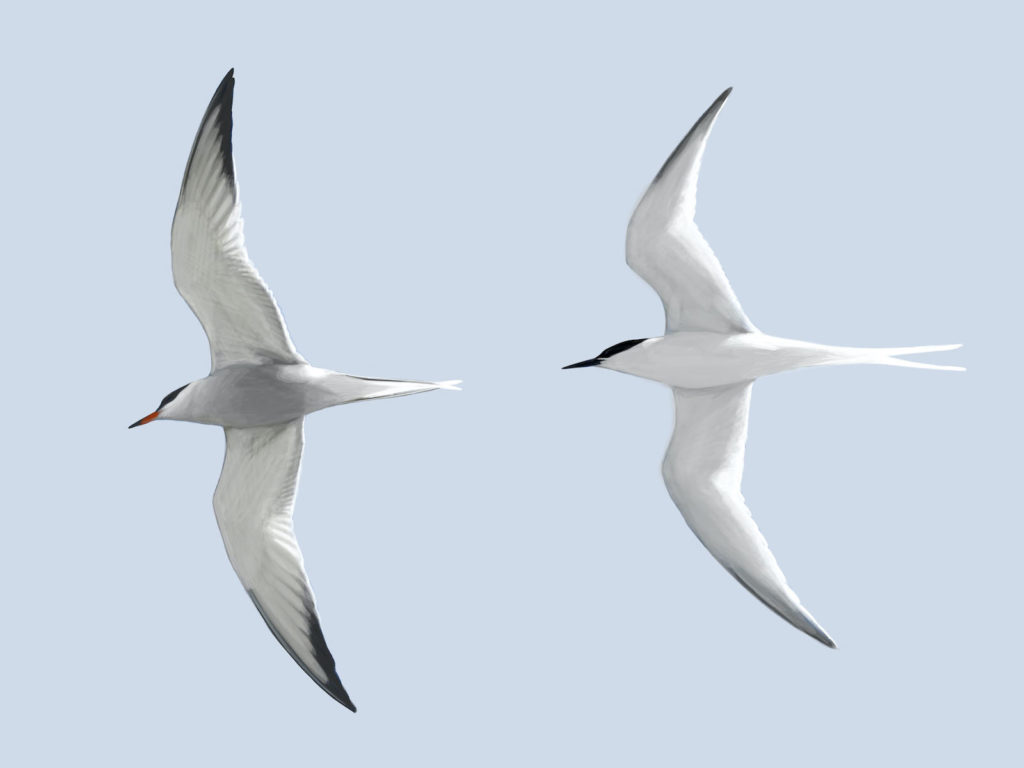
I was fortunate to be able to spend ten days in mid May 2021 on Great Gull Island, an American Museum of Natural History research site at the eastern end of Long Island Sound, New York. The island is occupied in summer by a very large colony of Common and Roseate Terns (among the largest colonies in the world of either species), and I was able to study thousands of Common Terns and hundreds of Roseate Terns every day.
Terns are overhead twenty-four hours a day, and both species perform elaborate and very elegant flight displays, sometimes hundreds of feet above the island. I thought those birds, with the translucent white feathers of their wings and tail lit up by the morning sun, were particularly beautiful, and I worked on some sketches of their shapes and patterns. In this illustration I was focused on comparing the differences between the species.
Both species have a deeply forked tail with long streamer-like outer tail feathers (especially long on Roseate Tern). One thing I found interesting in this study is that the “fork” at the tip of the tail is formed by the crossing of the outer tail feathers. Instead of a V-shaped tail these two birds have an X-shaped tail.


Something I’ve noticed over the past few years relates to bill color in breeding Roseate Terns. Near Okinawa, Japan, and again in eastern China, I’ve seen breeding Roseates with fully red bills. This baffled me at the time because I could not find any illustrations in any field guides of Roseates with fully red bills. However, starting with PUP’s Australian Bird Guide and now including Harrison et al.’s new edition of Seabirds, I’ve see a few illustrations of such Roseates. East Asian Roseates apparently show all-red bills. Have you seen any Roseate Terns in the US with all-red bills? Is it strictly an East Asian trait?
Hello! I was recently on a twitch stream with the accomplished and well-traveled young US birder Ian Davies, and he explained that outside the US, most (all?) populations of Roseate Terns have completely red/orange bills in the breeding season. This was news to me! I’m not 100% sure, but I think the all-black bill in alternate plumage may be unique to the ROST populations that breed in North America. It’s interesting! I’m curious why they are all considered the same species, if they have disparate breeding (and wintering) populations with distinct morphological traits. I’m guessing DNA studies support grouping all populations as the same species but I’d like to learn more about this.
Hi Zenaida and David, thanks for the comments! Here in the northeastern US bill color changes at different stages of the nesting cycle. Roseate Terns have all black bills during courtship, but develop red at the base up to about half of the bill during chick-feeding time, maybe for 6-8 weeks. I’ve seen birds with more than half of the bill red, but never completely red here. I think it’s similar in the British/Irish population and in the Caribbean. I’m not familiar with the Asian and Australian birds, but wonder if they also show maximum red during chick-feeding?
Differences between populations physically and genetically are very small, and bill color is too changeable and variable to be diagnostic. It’s a species with a really unusual global range, in small and disjunct pockets across temperate and tropical oceans in northern and southern hemispheres. Trying to explain that would make a very interesting and challenging project!